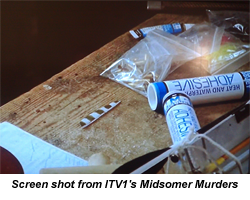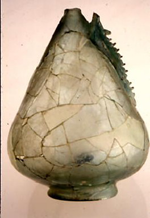 Google HMG adhesives on the web and there are many references to these products in scholarly articles and books on the conservation of antiquities, unsolicited recommendations from bodies like UNESCO and the Association of Independent Museums, and countless acknowledgements in restoration projects by the British Museum, the British Archaeological Society and their counterparts overseas. Eagle-eyed HMG staff are also used to playing ‘spot the HMG adhesive on TV’, with recent sightings on BBC Four’s authoritative ‘Greek Myths’ archaeological series and ITV’s peak-rating ‘Midsomer Murders’, in a scene featuring star John Nettles.
Google HMG adhesives on the web and there are many references to these products in scholarly articles and books on the conservation of antiquities, unsolicited recommendations from bodies like UNESCO and the Association of Independent Museums, and countless acknowledgements in restoration projects by the British Museum, the British Archaeological Society and their counterparts overseas. Eagle-eyed HMG staff are also used to playing ‘spot the HMG adhesive on TV’, with recent sightings on BBC Four’s authoritative ‘Greek Myths’ archaeological series and ITV’s peak-rating ‘Midsomer Murders’, in a scene featuring star John Nettles.
HMG Heat & Waterproof nitrocellulose adhesive and HMG B72 acrylic solution both share all the desired hallmarks of an adhesive appropriate for archaeological materials and antiquities: notably, the correct levels of plasticity and viscosity required for good workability, ‘water-white’ transparency, excellent physical and chemical stability properties and lasting reversibility with a range of solvents appropriate to the substrates under repair or restoration. Unlike epoxy resins and cyanoacrylate ‘super glues’ that are virtually irreversible after use, HMG’s conservation-grade adhesives are formulated to be permanently reversible and resoluble in certain solvents, so that repaired artefacts can be subsequently unglued for correcting mistakes, adding newly-found shards or fragments, or testing with new analytical techniques.
The internationally respected York Archaelogical Trust, an independent operating charity founded in 1972, is a dedicated professional user of these HMG adhesives, with individual devotees of each type. Principal Conservator, Ian Panter, has a marked preference for the traditional nitrocellulose, while his colleague Margrethe Felter opts for B72.
 “I suppose it’s an age thing,” says Ian, “I was brought up with HMG H&W adhesive and it does a fantastic job. You apply it straight from the tube and join the pieces together, applying slight pressure, then it sets almost immediately. The fact that it’s fully reversible is very important, because it allows us to take the adhesive off without any damage to the artefact. We deal with all types of materials, preserving archaeological objects from the Iron Age through to the 19th century, and we find HMG’s adhesives are suitable for most of our work.”
“I suppose it’s an age thing,” says Ian, “I was brought up with HMG H&W adhesive and it does a fantastic job. You apply it straight from the tube and join the pieces together, applying slight pressure, then it sets almost immediately. The fact that it’s fully reversible is very important, because it allows us to take the adhesive off without any damage to the artefact. We deal with all types of materials, preserving archaeological objects from the Iron Age through to the 19th century, and we find HMG’s adhesives are suitable for most of our work.”
Fellow Conservator, Mags, prefers using B72 acrylic adhesive, because of its longer drying time: “It retains its tackiness and gives you good working time, enabling you to put shards together precisely,” she says. “It has good ageing properties, with no tendency to yellow over time, and is reversible, so that you can go back and correct any mistakes, either the next day or even in many years’ time. I know some conservators make up their own acrylic B72 adhesives, but HMG’s tubes are very good and you can literally squeeze out exactly what you need from the fine nozzle.”
“I do find their Heat & Waterproof cellulose nitrate adhesive useful too though, especially when I want instant tack properties,” she adds.
For the technically-minded, HMG Heat & Waterproof Adhesive, originally developed by the company’s founder Herbert Falder during World War II, is a single-pack, clear product, with good all-round adhesion to ceramics, metal, wood, paper, leather and cloth, withstanding water and heat up to 100˚C. It is touch dry within 5 minutes and hard dry in 10 minutes.
In contrast, HMG B72 Acrylic Adhesive is touch dry in 3-5 minutes, surface dry in 1 hour and hard dry in around 6 hours. Not having instant grab, fragments can be easily re-adjusted and surplus adhesive removed with acetone, making any joint virtually invisible. It’s ideal for repairs to pottery, wood, metal, glass, ivory and many porous substances.
“Artefact restoration and preservation is an important conservation task, safeguarding items of historical interest for future generations. We are proud that our museum-grade adhesives, one developed by my own grandfather, are playing a small, but vital role in the repair of valuable historic finds, including I understand the skull of the first hominid skeleton, dating back more than 3 million years,” says HMG’s Managing Director, John Falder. “These are small volume products for a specialist niche market and it’s pleasing to see them rated by experts as among the best of their kind in the world.”
Enquiries to HMG Paints at Riverside Works, Collyhurst Road, Manchester M40 7RU, telephone 0161 205 7631, email sales@hmgpaint.com, www.hmgpaint.com
